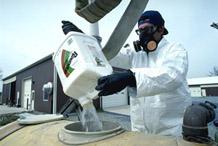Label Review Training: Module 3: Special Issues, Page 20
Section 5: What is worker protection labeling?
Worker Protection Standard
The Worker Protection Standard (WPS) establishes standards and labeling requirements for worker protection. Pesticide Registration (PR) Notices 93-7 and 93-11 provide EPA guidance for complying with WPS. The correct product-specific WPS labeling can be found in the toxicology review memo which summarizes the Acute Toxicity Data Evaluation Record (DER) for any given product.
As part of the pesticide registration, reregistration, and registration review processes,  EPA performs a comprehensive worker risk assessment. The worker risk assessment is based on toxicological criteria and potential for dermal, ocular, oral, or inhalation exposure. Based on that risk assessment, worker protection labeling specific to the active ingredient is established. When necessary to address risk to non-WPS workers, the regulatory assessment document goes beyond WPS to provide labeling protection for those workers not subject to the WPS. Chemical-specific worker protection labeling requirements can be found in the regulatory assessment documents (e.g., reregistration eligibility decision [RED] documents).
EPA performs a comprehensive worker risk assessment. The worker risk assessment is based on toxicological criteria and potential for dermal, ocular, oral, or inhalation exposure. Based on that risk assessment, worker protection labeling specific to the active ingredient is established. When necessary to address risk to non-WPS workers, the regulatory assessment document goes beyond WPS to provide labeling protection for those workers not subject to the WPS. Chemical-specific worker protection labeling requirements can be found in the regulatory assessment documents (e.g., reregistration eligibility decision [RED] documents).
To determine the correct worker protection labeling for a given product, the label reviewer must consider the chemical-specific worker protection labeling defined by the RED, the most current regulatory risk assessment document, and the product-specific labeling defined in the acute toxicity review and/or guidance contained in the Label Review Manual. In most cases, the correct worker protection labeling is determined by taking the most restrictive statements from each source.
Resources
For more information about WPS, see Chapter 10 of the Label Review Manual.
For EPA guidance on complying with WPS, see PR Notice 93-7 and PR Notice 93-11.
Page 20 of 43
Previous Page Next Page
